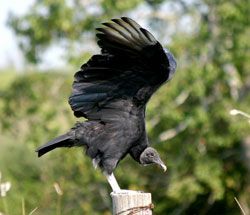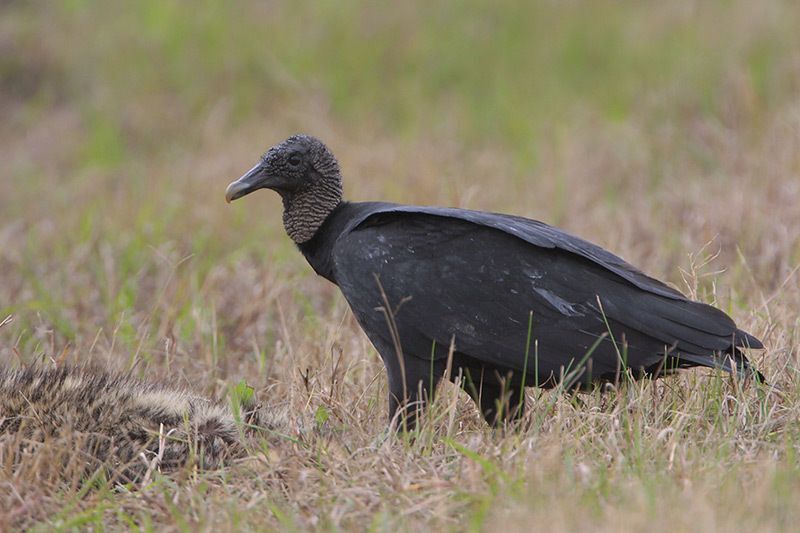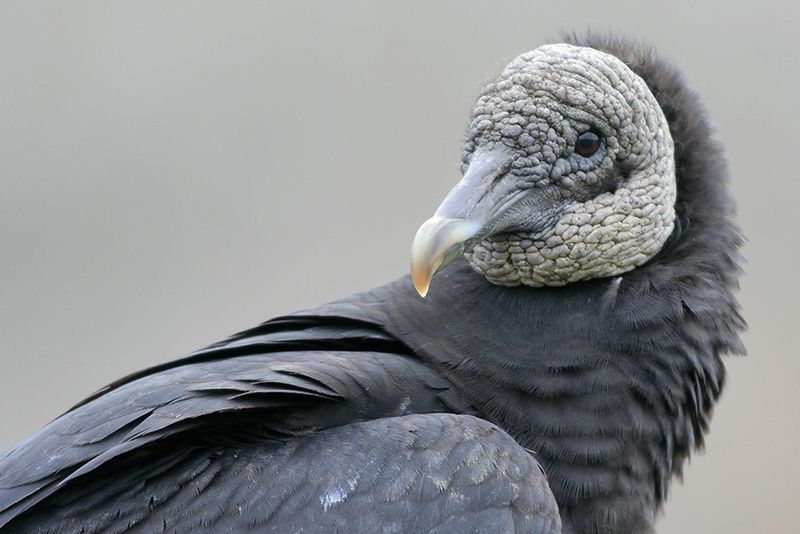Black Vulture

© Helen Baines
Coragyps atratus
Family: (Cathartidae) New World Vultures
Preferred Habitat: Woodlands
Seasonal Occurrence: Very common throughout the year. Permanent resident.
Profile by Daniel Elting: The Black Vulture is a large raptor with sooty black body feathers and a bald gray head. It is distinguished from the other common North American vulture the Turkey Vulture by its more compact body shape and bright gray wing tips. Although not considered one of the most conventionally beautiful birds, Black Vultures are extremely important to the health of the ecosystem.
Black Vultures are a component of nature’s cleanup crew, they exclusively consume rotten carrion and play a huge role in curbing the spread of disease in an ecosystem. The equally abundant Turkey Vulture homes in on carrion by using its acute sense of smell, but Black Vultures do not share this gift. Black Vultures mostly find carrion by using their vision to home in on Turkey Vultures that have found carcasses, the Black Vulture would not be nearly as abundant if not for the Turkey Vulture. Although Turkey Vultures are larger than Black Vultures, Black Vultures are more gregarious and will fight the mostly solitary Turkey Vulture off a carcass by banding into small groups.
Black Vultures nest in dark cavities such as caves, thickets, hollow trees and abandoned buildings. They form very extremely long term monogamous bonds with their mates. Pairs will roost and forage together year-round and will reuse successful nesting spots for years. Black Vulture chicks take relatively long to mature (~80 days) and adults will continue to feed the fledglings for up to eight months after they fledge.
Black Vultures are ubiquitous across eastern North America and South America. This is a bird you will often see driving along any highway in Texas either soaring over head or scavenging roadkill on the side of the road. Hundreds of Black Vultures and Turkey Vultures roost in and around our sanctuaries at High Island and are constantly seen soaring overhead during the day.
Profile by Grace Yaros: Black Vultures are large, all-black vultures with unfeathered, dark gray heads. They feed primarily on carrion, though they will occasionally hunt small fish or mammals. Black Vultures are common within their range, and can be found from the eastern United States to southern South America. Recently, their range has been expanding northward into New England. They usually breed and roost in forested habitats, but forage in open areas, including around roads, pastures, and towns.
Black Vultures may be confused with Turkey Vultures, with which they often associate. Turkey Vultures have an excellent sense of smell that they use to locate carcasses, and Black Vultures will often follow Turkey Vultures to carcasses, as their sense of smell is weaker. Turkey Vultures are slightly larger than Black Vultures and have bright red heads (but be aware that juvenile Turkey Vultures have grayish heads). They also have different proportions: Black Vultures have short, square tails, while Turkey Vultures have relatively longer wings and tails. Also note the color of the wings in flight: Black Vultures also have entirely black wings except for silver patches on their wingtips, while the wings of Turkey Vultures are bicolored, with grayish flight feathers.
These handsome scavengers are very social. Mated pairs form long-term bonds, and related individuals form communal roosts and maintain strong social bonds with each other. Today, their populations are stable (even increasing!), but historically, Black Vultures were negatively impacted by DDT. Because they are scavengers, they are also at risk of lead poisoning from ingested lead shot and bullet fragments.
-
Cornell Lab of Ornithology
-
Field Guide

© Greg Lavaty, www.texastargetbirds.com

© Greg Lavaty, www.texastargetbirds.com

© Greg Lavaty, www.texastargetbirds.com

We used to say that the BVs watched TV.




















